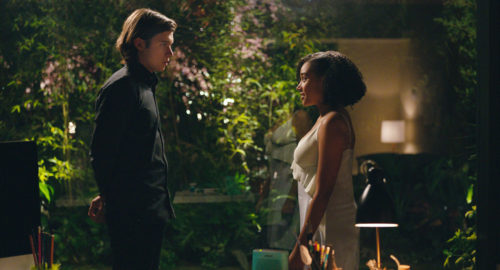The main dramatic trope which Everything Everything plays on dates back at least to 1848. It’s unlikely that director Stella Meghie and writer J. Mills Goodloe are unaware of this, since the film does not exactly hide the way it uses the trope. The 1848 work is Alexandre Dumas’ La Dame aux Camélias, which was adapted to film numerous times (famously with Greta Garbo in 1936 as Camille), used as a loose inspiration for romantic hit Love Story (1970), loosely adapted as a musical with Moulin Rouge! (2001) and given the teen focus with A Walk to Remember (2002). The main aspect of the trope concerns an amenable boy falling in love with an amenable girl. The girl becomes sick (or was always sick, depending on the iteration) and ultimately succumbs to her illness, but the sincerity and power of their love lives on.
This is not a spoiler for Everything Everything. Not really. But I mention this trope because nothing about Everything Everything, from its trailer to the entirety of its first hour, avoids the undertones. Instead, the film leans in. Heavily. And understandably. Having a supposedly terminally ill lead in a love story immediately injects every interaction with urgency and so Everything Everything presents us with a story that leaps from plot point to plot point with swiftness. Amandla Stenberg plays Maddy, a just turned 18-year old who suffers from a disease that prevents her from leaving the house. She has lived mostly contentedly in her bubble of a house with her nurse and her mother, who is also her doctor.

Her peaceable, if banal, existence is pierced by the arrival of the new neighbours and specifically the son, Olly, played by Nick Robinson. The two spy each other from across their yards (naturally, their bedroom windows face each other) and seem to fall in love instantly. What follows for the first hour is as you expect. And because we know Maddy is sick, their interactions play as just a bit more significant. Maddy begins to grow in her independence and Olly is key to that. And aided by the helpful nurse (literary motif #2 – the Romeo and Juliet parallels do not seem accidental either), and to the consternation of her watchful mother, Maddy begins to rebel. It’s nothing too overt or problematic. It’s the kind of rebellion that good looking teenagers with unbelievably good skin and bouncy hair have.
I knew, before I saw it, that I was not the target audience for Everything Everything. The romantic teen drama is unabashedly marketed to the teen audience, especially teenage girls. The cast of main speaking characters is small at six. Four of them are teenagers. Five of them are female. There’s no suggestion of a real world necessarily (everything is too beautiful, both outside and inside) and it could be read as a manifestation of Maddy’s own interaction with the world, which must be as antiseptic as possible. And for the majority of the running time, you are inclined to take it at face value even if for a non-teen-audience, the general triteness of the entire experience seems uninspiring.
At just about an hour into the film’s 90-minute running time, though, the Camille trope is abandoned for another one. And this is a spoiler: It veers into something aping Brian DePalma’s Carrie with a side serving of Gaslight and Tangled. For Everything Everything, clearly uncomfortable with leaning in too much with a trope that sees its flawless leads face mortality, opts instead for a twist which is not just silly but generally unearned. Certainly, as someone who this film is not necessarily for, my handwringing about issues, and general inconsistencies (Maddy has never left the house but magically knows how to swim when she finally meets the ocean, she manages to travel cross country and attain a credit card with no national ID) might come off as churlishness. Or the word that’s most often used to castigate critics: “nitpicking.” But faced with this dilemma, it bodes well to remember that to engage with Art on a level of respect, we must be willing to discuss it sincerely and seriously while holding it to high standards.
The sort of perfunctory laziness of Everything Everything, which wants to revel in its tropes but subvert them when they become too complex, should not be excused because it aims to be just a teen movie. Everything Everything when it does more than hobble does so mostly on the backs of its committed performers. Stenberg (best remembered for Hunger Games) and Robinson (excellent in the underseen Kings of Summer in 2013) make for a nice couple and at some level a romantic film depends on the charm of its leads. Tony winner Anika Noni Rose, as Maddy’s mother, is severely undeserved in a role that never quite meshes. For the film’s “twist” to work, Everything Everything must commit to more than a facile observation on teen love and become a complex film on parenthood and reacting to grief. It’s too lazy to do the latter and leaves us with a resolution that barely registers for its blandness to be good as the former.
Certainly, it is nice to have an interracial teen romance that never comments on the interracial aspect. Yes, it’s great to have a teen romance helmed by black female director. And certainly, it’s great to have a film where only one of the five main characters is a white male. But, Everything Everything barely registers more than to elicit a half-hearted shrug.
Have a comment?
Write to Andrew at




